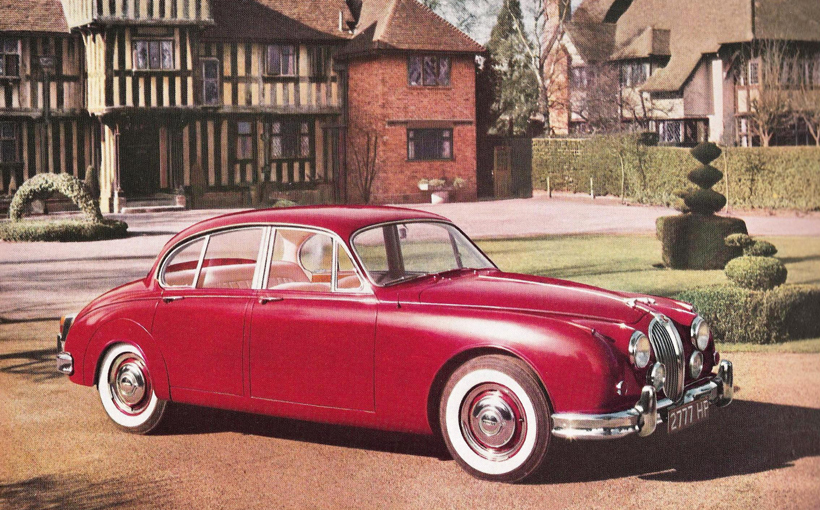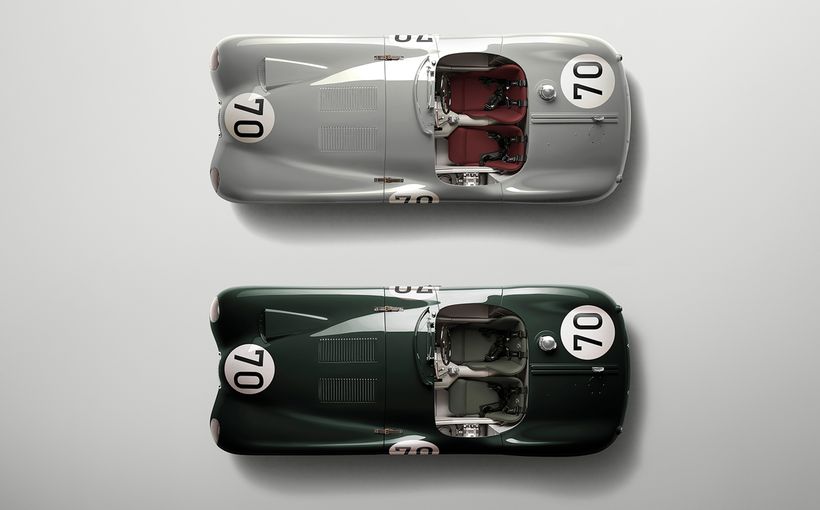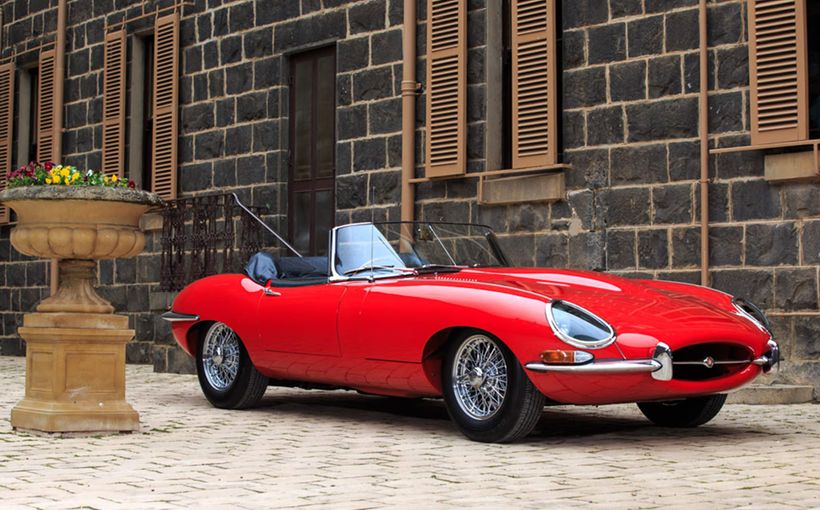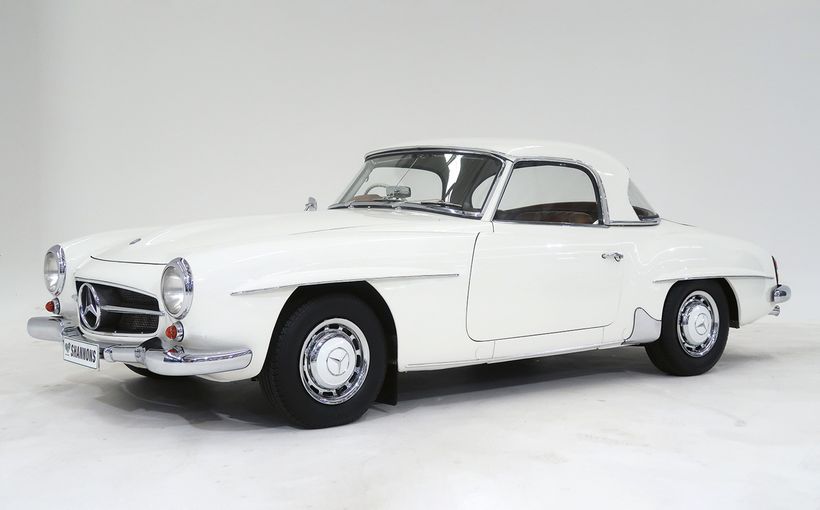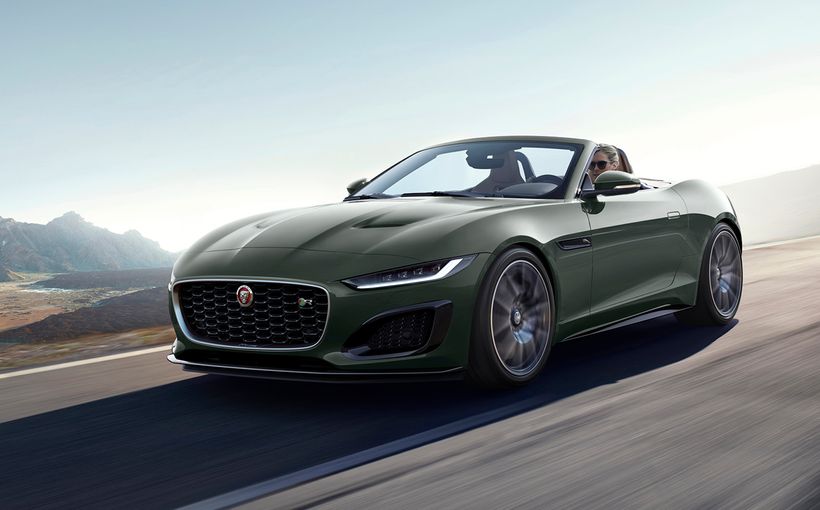1959-69 Jaguar Mk 2: Best Sports Sedan Ever? Only Sometimes

When the Jaguar Mk 2 was launched in October 1959, its new badge really meant something compared to today’s devalued applications of the Mk 2 badge. The Mk 2 was more a new model as it represented an advance in every area over the retrospectively-named Mk I it replaced. On its 1960 Australian arrival, the Mark 2’s value for money was exceptional especially the 3.8 manual, judged to be the world’s fastest sedan at the time.
With the passage of time, it has emerged that no four door saloon so accessible in price has been able to match the Mk 2’s combination of compact size, muscle-car performance, exceptional brakes and handling, wood and leather cabin appointments and almost perfect looks.
Yet all this depended on cottage industry suppliers maintaining quality on tiny economies of scale under knock down pricing and a motivated workforce to stitch it all together. Too often neither came together over the Mk 2’s long model life.

After the Mk I had been in production for just over three full years, the Mk 2 could still hold its own for another 10 years without major change. Despite Jaguar’s half-hearted attempt with the Mondeo-based X-type, the Mk 2 was never replaced.
Yet not all Mk 2 models are the same. The range covered an amazing spectrum of engine sizes and transmissions. There was also a popular Daimler V8 version, a model with its own character and handling balance, thanks to its compact 2.5-litre V8 that filled the gap between the entry Mk 2 2.4 and the mid-range 3.4.
Yet the Jaguar MK 2 didn’t begin and end in 1959. Every year brought changes that added refinement or performance or altered the value for money equation as the market required.

This late 1959-early 1960 example was typical of most Mark 2 examples that hit Australian roads with its skinny high profile cross-ply tyres, understated colour and simple, unadorned looks. At a time when the Jaguar XK 150 and Austin-Healey 100/6 were the must-have sports cars, this car merged both of those into an equally must-have four door sports sedan that could survive Australian roads at unprecedented speeds. (Photo from bpostwarclassics.runboard.com)
How Much Was New?
Was the new Jaguar a Mark II or Mk 2? Jaguar badges followed a law of their own. For the larger models, the company stayed with Roman numerals. The Mk 2 was a new direction and standalone model thus it was badged as a Mk 2, on the car and factory handbook, not Mk II. Where space allowed, it was also called Mark 2.
The intention was to keep it separate from the ever expanding sequence from Mark IV to Mark X so it wouldn’t start overtaking the Mark IV within two upgrades. After the model underwent its one and only facelift, it became the 240 and 340.
There was no Mark I and given the direct relationship between the two cars it made sense to call the earlier one Mark I although technically it should be Mk 1 with a numeral, not an upper case “I”. The first Daimler version of the Mk 2 was known simply as the 2 ½ liter, consistent with previous Mk 1 nomenclature, as this Daimler was the first of its kind and not a Mk 2 version.
It was then logical to rebadge it as the Daimler 250 when the Jaguars became 240 and 340 which in turn aligned the badging with larger 420 and 420G models. Many Daimler owners regard these 2 ½ and 250 badges as the same but they are no more interchangeable than Mk 2 3.4 and 340 as they were attached to cars quite different in detail.
So what defined the Mk 2? That list grew as the years progressed after the first examples carried over many fundamental Mk 1 parts including most inner body panels and dimensions. And even if not all final Mk 2 derivatives including the Daimler were badged as a Mk 2, they were variations of the same car, especially the Daimler which was being developed to continue the Mk 2 heritage on its own.

Rear view highlights how far Jaguar pushed the proportions of the Mk 1 shape to deliver the much needed extra cabin height and glass area, both right on the limit before they would have made the Mk 2 look silly. High ground clearance was a big plus for Australia and South Africa, both big export markets. (Photo from bpostwarclassics.runboard.com)
Exterior
- Although the body was an evolution, only the headlights, bumper bar, the bonnet leaper and grille badge were carryover. Even then, the front over riders were moved outwards to make room for the new auxiliary light position.
- The Mk I body was styled with heavy door frames and roof pillars to cover perceived extra strength requirements in Jaguar’s first unitary body. After much of this later proved surplus to requirements, the Mk 2’s hefty painted upper door frames became slender chrome-plated brass window frames for a big increase in side glass area. Although this made the Mk 2 look more modern at the time, it marked a step back to Jaguar’s older models. The Mk 1’s flush single-piece doors were in fact the way of the future.
- Slender front pillars housed a larger windscreen also an inch deeper. The roofline was correspondingly raised and ended in slender C-pillars housing a rear screen much wider and deeper.
- Front guards were changed to house separate parking light units in Jaguar’s old location at the top of each guard while separate rounded indicators below replaced the single rectangular units of the Mk 1. Although this anticipated the global trend for separate amber indicators, many also regarded this as a move back to 1940s Jaguar styling.
- Jaguar’s traditional horn grilles were replaced by additional lights (these were fog or driving lights depending on market and owner requirements) on most models as standard for most markets. These lights, in some markets including the US, were replaced by a new horn grille design.
- The Mk 2 grille was an update of the later Mk 1 and XK150 grille styles with an extra centre spine that merged into the matching centre strip on the bonnet.
- Extra brightwork on the roof gutters accentuated the Mk 1’s ground-breaking tear drop shape. The rear doors had an extended chrome-framed opening rear quarter window with catches shared with other top echelon British cars.
- Tail lights now incorporated amber, red and reflector sections similar to other Jaguar models but were located in unique chrome housings that followed the Mk 2’s rear contours. New bold upper-case JAGUAR and MK 2 badging identified the new model with 3.4 and 3.8 engine badges added when optioned. An AUTOMATIC badge was drilled into the bootlid below the engine badge, its holes becoming the first check point for an automatic converted into a manual. A circular DISC BRAKES warning badge with red triangle was mounted in the centre of the rear bumper which remained until the bumper design changed in 1967.
- A new panel below the rear bumper gave the body a more complete appearance and hid rear componentry.
- 72-spoke wire wheels were an option in silver stove enamel, chrome and body colour. These could be fitted to all Mk 2 models as the 11 inch disc brakes were standardized on all wheels on all models. The discs featured the revised “quick change” caliper design from the later Mk 1.
- Last but not least was a reworked rear wheel arch shape that allowed an increase in rear track of 3 ¼ inches/83mm within the existing body dimensions. The cantilever leaf spring live rear axle had extended rear axle tubes to cover the wider track but was still located with MK 1-type torque-arms and Panhard rod.

Last of the Mk 1 cabins versus the first of the Mk 2 cabins expose some cost savings and bold new driver-friendly dash layout achieved with the Mk 2. Wood content around Mk 2 doors was dramatically reduced and instrument mounting far less labour intensive but centre console compensated. Note correct carryover bulb-shaped knobs on both Moss gear levers but new pendant accelerator in early Mk 2 changed back to organ-style pedal within a year. Steering column window on this Mk 2 manual was used to indicate overdrive operation. (Photo from classic-sportscar.co.uk and bpostwarclassics.runboard.com)
Interior
The big change was the brand new dash layout and cabin that continued well into the Jaguar XJ6 range with variations for the E-type and the Mk X.
- Major instruments including a new oversize speedometer and tachometer were moved in front of the driver. Their extra size allowed twin odometers and an inset clock at the base of the tacho. Minor gauges were spread across the centre panel.
- All switchgear was toggle-type except for the traditional chrome headlight switch and the redesigned starter button next to the ignition lock. All models gained a trimmed centre console with sliding heater controls and radio/speaker when fitted. The 2.4 featured a manual choke control on the dash, right of the speedo.
- The reach adjustable steering column featured a twin spoke steering wheel with half horn ring, more forgiving and attractive than the primitive four spoke Mk 1 item in a crash. Automatic transmission models had a window above the steering column to indicate selection. This became an overdrive indicator on manual versions fitted with overdrive.
- A pioneering brake warning light that covered handbrake operation and brake fluid levels was a welcome addition in the era of single circuit brakes.
- Seats and door trims were generally upgraded and better integrated, extra storage provided in the doors and there was more extensive cabin lighting. New wood picnic tables were fitted in the backs of the front seats while wood door trim still capped the doors and centre pillars but no longer lined the side glass with the arrival of the new slimline upper door frames.

The MK 2 introduced a third engine option, a special twin carburettor version of the 3.8 with a choice of automatic and four speed manual with overdrive. Oil filter design, sump, carburettors, cylinder head, air filters, generator, exhaust maniflds, camshaft covers were just some of the many items changed over the Mk 2 model life.
A Cat’s Head for Purring Or Deep Breathing
Although Mark 2 capacities of 2.4, 3.4 and 3.8-litres never varied after the 3.8 was added to the range, the cylinder head fitted to each model could make all the difference.
The original metal-coloured head fitted to the early Jaguar 3.4 engines were called the Type A retrospectively. It was joined by a special red Type C head developed for the racing XK 120C then later offered as an option on later XK 120SE and 140SE models. Its valves were boosted to 1 5/8 inches with porting increased to match.
This valve size was carried over into a new head design with its valve angles changed to a much wider angle. Known as the Type B head, it was initially fitted to the standard XK 150 to maintain Type C power with extra flexibility.
This head was offered on all Mk 2 engines including the 2.4 for the first time. Colours for the Type B head as fitted with twin carburettors during this period were a light blue-green. The Mk II 3.8’s Type B head was usually a mid-metallic blue.
Fitted with the Type B heads but the earlier Mk I’s twin Solex downdraught carburettors, the 2.4 output jumped from the Mk I’s 112 to 120bhp/89kW,while the twin side-draught SU version of the 3.4 offered 210bhp/156kW and the 3.8 220bhp/164kW.

This new dry element pancake air cleaner design appeared under the 3.4 and 3.8 bonnets shortly after release. Earlier oil bath filter continued in the 2.4 with its different twin Solex downdraught carburettor arrangement. Note the polished alloy cam covers and glass washer bottle deleted from later models. (Photo from classic-auctions.com)
The Type C straight port head, initially in pumpkin orange and later gold, was usually fitted to high-compression triple-carburettor 3.8 applications such as the E-type and Mk X. A special version of this Type C straight port head was fitted to the final 2.4-litre engines after 1967 with twin SU side-draught carburetors replacing the downdraught Solexes.
For competition use, this Type C head was specified for the Mk 2 and usually combined with quick-ratio steering box, lighter flywheel, competition clutch, upgraded anti-roll bar, close-ratio gearbox, high lift camshafts and Powr-Lok limited slip differential (already fitted to the 3.8 manual as standard).
This Type C head was also fitted to the later 240 and 340. All Type C heads fitted to these later twin-carburettor Mk 2 derivatives were metal coloured when combined with the later ribbed cam covers that also arrived at this point. Power jumped from 120 to 133bhp/99kW for the 2.4 but claimed figures remained the same for the 3.4.

Late model 340 engine bay highlights new cross-over dry element air filter, ribbed cam covers and unpainted heads of final versions. (Photo from classicandsportscar.ltd.uk)
After the MK 2 3.8 was withdrawn in 1967, there was no official 380 but about a dozen examples of the 340 were sold with 3.8 engines upgraded with straight port Type C heads and twin-carburettors (source:Jaguar Mark 1 & 2 by Nigel Thorley). It is safe to assume the last 3.4 and 3.8 engines were much livelier than the Mk 2 versions they replaced even if there was no hint of revised figures.
For the last 3.8 cars, the usual 340 body identification applied with only the 3.8 badges to indicate what was under the bonnet. They defined the rarest production specification of all.

The Jaguar Mk 2 tool kit was always comprehensive and now worth big money on its own. Note the original tin for the brake-bleeding kit, an indication of the extent Jaguar owners were expected to bond with their cars. (Photo from collectableclassic.com.au)
All early Mk 2 engines including the first 3.8 versions carried over the two Mk I oil bath air cleaner designs specific to the different SU and Solex carburettor configurations. Within a year, a pancake-style dry element air cleaner was fitted to the 3.4 and 3.8 side-draught SU engines. All final models with Type C heads, which were all carrying side-draught SU carburettors by this stage, featured a variation of the later cross-over oval tube dry element air filter.
The 3.8-litre block was more than a bored-out version of the 3.4. A new block with steel liners anticipated any tendency for the bores to crack. It was just the start of ongoing improvements.

John Coombs was a Surrey Jaguar dealer and gave Mk 2 owners the choice of upgrading a car for competition after it was built, instead of having to pre-order the work through the factory. No two Coombs cars were alike but most involved a full strip down of engine and gearbox with upgraded or balanced internals with the rest following from there. (Photo from classicandsportscarltd.uk)
A Litany Of Changes
1960: Shortly after release, the 100lb psi oil gauge scale was changed to a 60lb maximum so the oil pressure wouldn’t appear as low and frighten owners. Early cars had indicator stalks on the right, auto or overdrive stalks on the left. These were swapped during 1960, about the same time as the air-cleaner changes. The centre panel’s early black paint finish was replaced by black leather-grained trim. Later in the year, it had become apparent that the new slimline side window frames were too slim and had to be reinforced to prevent flexing and cracking. Also at this point, the recessed double-hinged sun visors of early cars were replaced by flush sun visors that could swivel for side glare. Standard steel wheels were upgraded to a 5J width over the Mk 1’s 4 ½ but the 6.40x15 tyre size remained the same.
1961: New metallic paint colours were offered including a bronze, dark green, dark blue, light blue and dark grey. The carryover Mk 1 front suspension geometry was upgraded to Mk 2 with forged top wishbones and lowered mounting points that lifted the roll centre from below ground level to above, aligning it better with the car’s centre of gravity. This was a significant change.
1962: Power-steering option was now offered on most markets after it was introduced late in 1960 for UK cars only. It dictated manifold changes to clear the pump. Sealed beam headlights replaced Mk 1 bulb-type. Front seat belt mounting points fitted. Steel sump was enlarged to accommodate a bigger oil pump.
1963: Bigger capacity generator. Front seat backs heavily sculptured to create extra rear leg room. Revised steering column matched Mk X’s new design followed by the Mark X steering wheel slightly later with its sculptured horn panel matching the spoke profile. A larger diameter tail shaft was fitted to all Mk 2 models around this time.
1964: Revised oil filter design arrived with new aluminium sump. Upgraded anti-roll bar.

After the Coombs cars and the competition Mk 2 3.8 factory cars, the hottest factory build Mk 2 were the dozen 340 examples fitted with the 3.8 engine upgraded with the Type C straight-port head. There is no external badging on this rare but widely acclaimed ex-police 340 3.8 to flag its special status. (Photo by Mike Hammond)
1965: Ever wondered why some Mk 2s had glass washer bottles and others didn’t? A new Lucas washer system for a toggle-switch controlled continuous flow was fitted. The classic glass reservoir on the passenger’s side was banished for a white plastic reservoir that looked like a disposable Nappy wash bottle. It was the beginning of the end as costs caught up with the Mk 2. Jaguar’s new all-synchro manual gearboxes were initially added as an option over the old Moss rock-crusher gearbox in mid-1965 then standardized across the range. Look for the bulb-shaped black knob on the Moss gear lever compared to the black ball on the Jaguar gear lever.
1966: In July 1966, Jaguar announced it was merging with BMC to become British Motor Holdings, a move that saw it rapidly swallowed-up by the British Leyland train wreck. By September, the Mk 2’s leather had been replaced by Ambla, a tough vinyl shared with Rover that looked like leather. Tufted carpet replaced the earlier plush pile. Leather became an option but the picnic tables were deleted at this point. Headlining and sun visors were standardized to match the S-type. The supplementary lights were replaced by horn grilles as for earlier US cars. The Daimler 2 ½ litre continued with leather and extra lights. Dunlop SP41 185x15 radial tyres were optional.

The lovely detail on the Mk 2 dash as seen on this desirable last of series 340 manual continued without compromise until the end. Note late model 60lb psi oil gauge that made the engine’s oil pressure look healthier than the earlier 100lb psi gauge. (Photo from collectableclassic.com.au)
1967: The final Mk 2 badged cars continued with detail changes until the range was revised to create new 240 and 340 models later in 1967. There was no 380 version. The traditional Armco-style bumpers were replaced by slimline items similar to the S-type which then dictated new lower panels front and rear. New hubcaps with a recessed black centre badge replaced the traditional hubcaps with fake centre knock-offs. To compensate, all engines were upgraded and prices were cut dramatically to face capable and more modern rivals. Badgework denoted 240 or 340 models. As described above, a dozen 340 examples were built with 3.8 engines.

The Mk 1 was shaped by science and Sir William Lyons’ ability to translate his XK sports car lines into a sedan. The Mk 2 was shaped by post war-recovery period’s need for extra glitter and cabin height for buyers not starved during Great Depression and World Wars, especially in export markets. Front seats underwent at least five changes to create more room for younger and heftier owners as highlighted in this 1967 240 publicity shot. If it wasn’t for the recessed side glass, the sleeker Mk 1 was closer to modern practice. (Mk 1 photo from cs.wikipewdia.org)
1968: The 340 was first to go in September as the 420 and early XJ6 were vying for the same buyer. The 240 and Daimler 250 continued.
1969: In April, the 240 was dropped. The Daimler 250 was the last Mk 2 derivative standing with production continuing for several months before it was dropped at the end of the year. Australian records indicate that the 340 continued locally until April 1969, the 240 until September 1969 and the Daimler 250 until October 1969.
Note: Because Australian Mk 2 examples have come from a wide range of sources long after local deliveries ended, placing exact dates on most of the above changes has been carefully avoided. RHD Mk 2s were even assembled in South Africa. The delay between when a certain part left Coventry and hit the road across far flung RHD markets was often considerable. The validity of anything being presented in a Mk 2 can only be determined by the chassis number. A useful starting point is the Haynes reference “Jaguar Mark 1&2” by Nigel Thorley. And if you are really serious, the “Jaguar Clubs of North America Mark 2 Judging Guide” by George Jones, which links most of these changes with chassis numbers, is invaluable.

Although subject to cost-cutting pressures inside the cabin, this final 340 manual remains one of the rarest and most desirable Mk 2 derivatives with its hotter 3.4-litre straight port engine and Jaguar all-synchro manual gearbox. Slender bumpers suited certain colours and chrome wire wheels. Note rear warning badge for disc brakes has gone which you couldn’t see until you hit the rear anyway. (Photo from collectableclassic.com.au)
Production Tallies
The rise and fall of the various Mk 2 derivatives provide some insight into how and why the later cars were changed.
1959-60: 2.4:7,836, 3.4: 6,032, 3.8: 6,199
1961: 2.4:6,459, 3.4: 6,050, 3.8: 8,727
1962: 2.4:3,358, 3.4: 4,660, 3.8: 4,725
1963: 2.4:2,857, 3.4: 4,155, 3.8: 3,241 plus 2,444 Daimler 2 ½ litre V8
1964: 2.4:1,904, 3.4: 3,539, 3.8: 2,631 plus 3,696 Daimler 2 ½ litre V8
1965: 2.4:1,355, 3.4: 2,091, 3.8: 1,401 plus 3,430 Daimler 2 ½ litre V8
1966: 2.4:1,592, 3.4: 1,454, 3.8: 689 plus 2,200 Daimler 2 ½ litre V8
1967: 3.4:685, 3.8: 2,528, 240:911, 340: 1,005 plus 803 Daimler 250 V8
1968: 240:2,827 340: 1,799 plus 2871 Daimler 250 V8
1969: 240:692, 340: 0 plus 1,223 Daimler 250 V8
Total Production: 83,701 (Mk 2 only). 108,850 (Mk 2 plus Daimler V8, 240,340)
2.4: 25, 173, 3.4: 28,666, 3.8: 30,141, 240: 4,446, 340: 2,796
Daimler 2 ½ litre and 250: 17,260 (incl 4,897 Daimler 250)
Note: Separate production totals for 1967 MK 2 derivatives are not widely available and were calculated by subtracting 1959-66 tallies from total production.

Jaguar business model, which depended on low paid workforce stitching together low volume bits of variable quality from cottage industry suppliers, was already unravelling under 1960s UK wages push, well before British Leyland. More modern rivals including Triumph 2000, Rover 2000(left), Ford Zodiac Mk IV (right) and Vauxhall Cresta, built and priced under more sustainable assembly practices with larger economies of scale decimated Mk 2 sales from above and below. The XR/XT Falcon GT at 60 per cent of the Mk 2 3.8 price in Australia had a similar impact. (Photos from aussiefrogs.com and regarchive.com)
Some Vital Stats:
The Mk 2 had a wheelbase of 107.4inches/2.73m and a length of 181 inches/4.59m. A width of 67 inches/1701mm placed it on the Japanese width limit. Its front track of 55inches/1397mm remained slightly wider than the rear 54inches/1372mm.
In wheelbase and length, it was slightly bigger than an EH Holden and identical to a Mark III Zephyr. It says something for the styling that you would not associate the Mk 2 with either of those cars in size or presence.
The 2.4-litre version weighed 1447kg, the 3.4, 1499kg, and the 3.8, 1510kg or 1524kg (manual with overdrive). The Daimler 2 ½ Litre V8 weighed just 1382kg explaining its nimble feel and better handling balance generated by the small and light V8 with its cast iron block and alloy heads. It also highlighted how much extra weight the big Jaguar engine was placing over the front wheels.
Tests at the time suggested the 2.4 was only good for a 96mph/154km/h top speed, a 0-60mph (96km/h) time of 17.3 seconds and a standing quarter mile of 20.8 seconds, something that Jaguar tried to overlook by not supplying a factory test car. The 3.4 raised these figures to 119mph/190km/h top speed, 11.9 for the 0-60mph and 19.1 for the standing quarter. The 3.8 pushed this out 125mph/200km/h, an 8.5 second 0-60mph and a 16.3 second standing quarter.
The Daimler V8 was the dark horse as it clocked 110mph/177km/h, a 0-60mph time of 13.5 seconds and standing quarter of 19.8 seconds.
With Jaguar’s latest quick-shifting all synchro gearbox, the performance improvement was dramatic in combination with the new cylinder heads on the final 240 and 340 models. Fuel consumption was also improved by up to 30 per cent.
This combination allowed the 240 to hit a 106mph/170km/h top speed, post 12.5 seconds for the 0-60mph and 18.7 for the standing quarter. The 340 top speed climbed to 124mph/198km/h and the 0-60mph dropped to 8.8 seconds with a standing quarter figure of 17.2 seconds. The 3.8 and its significantly greater fuel consumption could no longer be justified by the extra performance, a trend that sales were already highlighting.
The little Daimler didn’t miss out either as its top speed pulled up at the same 106mph/170km/h as the 240 with similar gearing but its 11.1 second 0-60mph time and 18.5 for the standing quarter represented major gains. It also provides some insight into why the stillborn Mk 2 replacement was to be based on this Daimler V8 combination. This car became redundant as soon as Jaguar became part of the same Leyland stable as the Triumph 2.5 and Rover 3500 models.
These cumulative gains suggest the rare 340 3.8 versions built between the end of 1967 and May 1968 with the latest Jaguar manual gearbox would have cracked the 15 second barrier for the standing quarter, a 0-60mph figure in the sevens and a top speed over 130mph/208km/h. Unfortunately, one was never tested at the time but it does explain why a handful were snapped-up by British police forces.

The 240 and 340 could easily have been Jaguar’s swansong if the XJ6 failed to generate the volumes and higher price to cover Jaguar’s old school business model. Jaguar's later dependency on sole XJ platform was almost terminal until Ford ownership transformed build practices and component quality to the point where a serious Mk 2 replacement is now viable. (Photo from aronline.co.uk)
Kitty Litter or a Big Cat’s Litter
Unfortunately, the Mk 2 range could happily deliver both.
No single model has invited such a diverse group of buyers free of gender bias, all of whom wanted something different from each variation. The Mk 2 catered for the comfortable but elderly local potterer, the abstemious, an ex-pat wanting to fly the flag, wealthy but remote colonial land holders, the suave top end of town luxury car buyer, the motor sport wannabe and the racing professional, and just about anyone in between, including an unusually strong female following.
The early Mk 2 2.4 continued because there was a market still jittery over oil supplies after the Suez crisis, the same thinking which prompted the Mini in the same year. The sales numbers justified it but as a sub-100mph car with the same maintenance and repair costs (and restoration costs today) as the others, it left Jaguar wide open to better alternatives from Triumph and Rover.
And even if you stretched to a bigger-engined Mk 2, you could still bring home a pedigreed cat with genetic flaws, serious enough to want to put it out of its misery. Under the flawed Jaguar business model, it could be a lottery whether your new Mk 2 3.8 arrived missing vital body welds leaving it as loose and rattly as a good one was refined and tight. Jaguar gave new meaning to Monday and Friday cars and vulnerability to structural rust.

Improving on the Mk 2 Jaguar was a global obsession as most examples needed so much new metal during a rebuild. This latest love-it or hate-it example, by current Jaguar design chief Ian Callum, doesn’t reflect his usual mastery when updating a heritage. With so many touches out of kilter with the original, is its real purpose a transition exercise for a coming small Jaguar? (Photo from telegraph.co.uk)
An early 3.8 manual with overdrive and wire wheels remains the obvious choice for performance and involvement but a good 3.4 manual was never too far behind. And the automatics made a good case for extra refinement and driving ease as long as the old Moss gearbox was the only manual choice.
A closer examination of where Jaguar took the MK 2 exposes some real gems. The no-nonsense specification of the 240, 340 and Daimler 250 combined with Jaguar’s new manual gearbox, the later slim line bumpers, one of the later metallic or solid colours and chrome wire wheels can define several rare and desirable variations, not all of them top of mind.

This view of the Callum Mk 2 begs the question: Who had the better eye for Jaguars, Lyons or Callum? Yet the car has hit the spot with some fans who have pressured the constructors to build a limited run.(Photo from telegraph.co.uk)
For many collectors, none of this is enough. Companies all over the world, including some of the world’s best in Australia and New Zealand, will re-define the Mk 2 for a fat cat fee with later Jaguar V8 engines, modern autos, rack and pinion steering, independent rear suspension, climate control and wide wheels and tyres. Yet in a strange way, these “improved” cars seem more successful at highlighting how right the original cars were.
Protect your Jaguar. Call Shannons Insurance on 13 46 46 to get a quote today.

